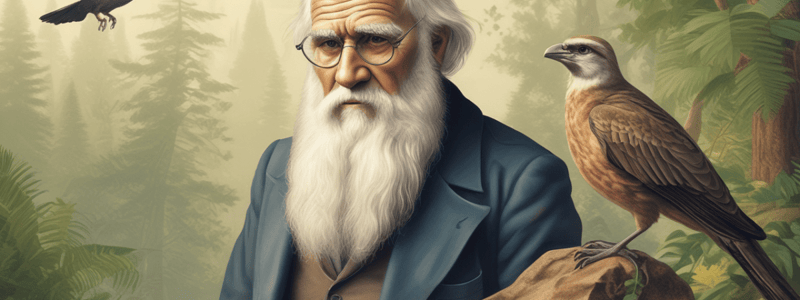Podcast
Questions and Answers
In what year did Charles Darwin embark on his voyage on the HMS Beagle?
In what year did Charles Darwin embark on his voyage on the HMS Beagle?
- 1851
- 1801
- 1821
- 1831 (correct)
Which scientist proposed that natural laws are constant through time (uniformitarianism)?
Which scientist proposed that natural laws are constant through time (uniformitarianism)?
- Charles Lyell (correct)
- Jean-Baptiste Lamarck
- Charles Darwin
- James Hutton
Which example was given for global variation?
Which example was given for global variation?
- Finches in Galápagos with different beaks
- Lions in Africa and tigers in Asia
- Ostriches in Africa and rheas in South America (correct)
- Glyptodonts and armadillos
Who stated that the geological processes are connected to Earth's geological features?
Who stated that the geological processes are connected to Earth's geological features?
Which of the following is NOT one of the three types of diversity mentioned in the notes?
Which of the following is NOT one of the three types of diversity mentioned in the notes?
What happens when there is variation in fitness in the struggle for existence?
What happens when there is variation in fitness in the struggle for existence?
What principle explains that all species descend from common ancestors and are diverse because of adaptation?
What principle explains that all species descend from common ancestors and are diverse because of adaptation?
Which type of structure is inherited from a common ancestor but has lost much of its original size and function?
Which type of structure is inherited from a common ancestor but has lost much of its original size and function?
What provides evidence that modern organisms descended from extinct ancestors?
What provides evidence that modern organisms descended from extinct ancestors?
Which field of study looks at where organisms and their ancestors live now and where they lived in the past?
Which field of study looks at where organisms and their ancestors live now and where they lived in the past?
What is the estimated age of the Earth according to the content?
What is the estimated age of the Earth according to the content?
What did Jean-Baptiste Lamarck incorrectly believe about how organisms evolve?
What did Jean-Baptiste Lamarck incorrectly believe about how organisms evolve?
According to Thomas Malthus, what would happen if the population grew unchecked?
According to Thomas Malthus, what would happen if the population grew unchecked?
Who had evidence to support their beliefs about evolution?
Who had evidence to support their beliefs about evolution?
What is the term for a heritable characteristic that helps an organism thrive in its environment?
What is the term for a heritable characteristic that helps an organism thrive in its environment?
How is 'fitness' defined in the context of natural selection?
How is 'fitness' defined in the context of natural selection?
What does population genetics support?
What does population genetics support?
What is allele frequency?
What is allele frequency?
What are the three ways genetic variation can occur?
What are the three ways genetic variation can occur?
How many genetic combinations are possible in humans due to sexual reproduction?
How many genetic combinations are possible in humans due to sexual reproduction?
How does natural selection on single gene traits affect populations?
How does natural selection on single gene traits affect populations?
What is the effect of nonrandom mating in a population?
What is the effect of nonrandom mating in a population?
Which of the following is true about small populations in terms of evolution?
Which of the following is true about small populations in terms of evolution?
What causes the gene equilibrium to offset in natural selection?
What causes the gene equilibrium to offset in natural selection?
Which form of reproductive isolation occurs when populations develop different habitats?
Which form of reproductive isolation occurs when populations develop different habitats?
How do new genes evolve?
How do new genes evolve?
What does the molecular clock use to estimate the age of species?
What does the molecular clock use to estimate the age of species?
Which type of selection occurs when individuals at one end of the curve have higher fitness than all others?
Which type of selection occurs when individuals at one end of the curve have higher fitness than all others?
What results in individuals with a certain allele randomly having more offspring than others?
What results in individuals with a certain allele randomly having more offspring than others?
Which effect describes a change in allele frequency due to a dramatic reduction in population size?
Which effect describes a change in allele frequency due to a dramatic reduction in population size?
How do allele frequencies change in the founder effect?
How do allele frequencies change in the founder effect?
What condition occurs when a population is not evolving, and allele frequencies remain the same?
What condition occurs when a population is not evolving, and allele frequencies remain the same?
Which principle states that allele frequencies should remain constant unless some factor causes them to change?
Which principle states that allele frequencies should remain constant unless some factor causes them to change?
Flashcards are hidden until you start studying
Study Notes
A Voyage of Discovery
- Charles Darwin formulated evolutionary theory to explain the diversity of life on earth
- Born on Feb 12, 1809, Darwin traveled around the world on the HMS Beagle in 1831
- Influenced by other scientists: Hutton, Lyell, and Malthus
Types of Diversity
- Global variation: ostriches in Africa, rheas in S America
- Local variation: finches in Galapagos, similar but different beaks
- Fossil variation: Glypthodonts, armadillos
Natural Selection
- Occurs in the struggle for existence when there is variation in fitness
- Principle of Common Descent: all species descend from common ancestors and are diverse due to natural selection and adaptations
Evidence of Evolution
- Biogeography: where organisms and ancestors live now and where they lived
- Patterns in species: fossils and living organisms, and geology
- Closely related organisms have different common ancestors
- Distantly related organisms have similar but uncommon adaptations
- Earth is estimated to be 4.5 billion years old
Fossils
- Show how modern organisms came from extinct ancestors
- Homologous Structures: similar among different species and adapting to different things
- Vestigial Structures: ancestor-inherited but lost size and function
- Analogous Structures: similar function, different structures
- Evidence of a common ancestor
Embryological Development
- Similar genes in all cells, using DNA, RNA
- Natural Selection in the richest (most varied) environments
17.3 Darwin's Theory
- Alfred Russell Wallace believed in natural selection, but Darwin had evidence
- Struggle for Existence: offspring number greater than carrying capacity, they compete for resources
- Adaptation: a heritable characteristic that helps an organism thrive
- Survival of the Fittest
Genes and Variation
- Population genetics supports Darwin's theory
- Gene pool: genes in a population
- Allele frequency: percentage of alleles for 1 gene present in a gene pool
- Evolution contains all changes in allele frequency
- Three ways of genetic mutation: lateral gene transfer, mutation, and genetic changing in sex reproduction
Evolution as Genetic Change
- Single gene natural selection can change allele frequencies, then changing phenotype frequencies
- Polygenic traits: many genotypes and even more phenotypes
Changes in Allele Frequency
- Polygenic natural selection can change fitness of phenotypes in:
- Directional selection
- Stabilizing selection
- Disruptive selection
- Genetic drift: change in allele frequency due to random events
- Bottleneck effect: change in allele frequency after a dramatic reduction in population size
- Founder effect: allele frequencies change due to migration of a population subgroup
- Genetic equilibrium: population is not evolving, allele frequencies remain the same
Hardy-Weinberg Principle
- Allele frequencies should be constant unless some factor causes a change
- Nonrandom factors: mating, small population, gene flow, mutations, and natural selection
Studying That Suits You
Use AI to generate personalized quizzes and flashcards to suit your learning preferences.




